Hungary Virtual Jewish History Tour
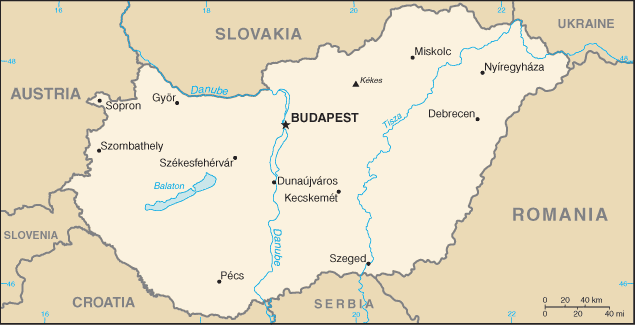 |
Jews have lived in Hungary since the time of the Roman Empire, even before the Magyar (Hungarian) tribes arrived and conquered the land in the 9th century. Today, the Jewish population of Hungary is approximately 46,500 people, the sixth largest Jewish community in Europe.
|
Learn More - Cities of Hungary: |
Middle Ages to Ottoman Empire
Ottoman & Hapsburg Empires
19th Century-World War I
Inter-war Period (1919-1939)
The Holocaust
Post-World War II Hungary
Communist Rule
Hungary Today
Relations with Israel
Middle Ages to the Ottoman Empire
The Jewish community grew in the second half of the 11th century due to large numbers of immigrants from Germany, Bohemia and Moravia. Jews settled in the towns of Buda, Esztergom, Sopron, Tata and Old Buda.
Restrictions were placed on Jews by Christian clergy and institutions. In 1092, the Church forbade Jews from intermarrying Christians, working on Sundays and Christian holidays and purchasing slaves. Despite the prohibitions placed on Jews by the church, Hungary served as a haven for Jews. At the end of the 11th century, King Koloman protected Jews living in his territory, in return for direct taxes to his treasury.
 |
During the 12th century, Jews held leadership positions in the economic institutions in Hungary. In 1251, King Bela IV gave Jews legal rights and welcomed Jewish immigration. Support for Jews by the King was counteracted by anti-Jewish laws from the church and the nobility. Their advancement was hindered by the nobles who proposed the “Golden Bull” article of 1222, prohibiting Jews from holding particular offices and receiving the title of nobility. By 1279, Jews were prohibited from leasing land and were forced to wear badges. Many of these anti-Jewish measures were not carried out because of the King’s objections.
The church’s influence grew during the reign of Louis the Great (1342-82). In 1349, Jews were expelled from Hungary due to the Black Death. Their expulsion was decreed officially in 1360, though by 1364, they were allowed to return. In 1365, the office of “judge of the Jews” was instituted and had to deal with affairs of Jewish property and taxes, representation in the government and protection of rights. It was also in the late 1300’s that Jews settled in Gyor, a city in northwest Hungary near the Austrian border.
The situation improved for the Jews during the reign of Matthias Corvinus (1458-90). Also during the 15th century, Jewish immigrants began settling in large numbers in the city of Buda. The economic and political situation deteriorated, however, in the late 15th and 16th century. In 1494, a blood libel broke out in Tyrnau and 16 Jews were burned at the stake.
Other riots followed in Pressburg, Buda and other towns. King Ladislas VI (1490-1516) canceled all debts owed to Jews. During the reign of Louis II, (1516-26), anti-Jewish feelings grew.
Ottoman & Hapsburg Empires
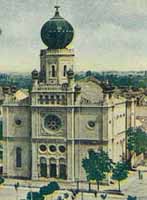 |
The Ottoman’s first conquest of Buda took place in 1526; many Jews joined the Turks in the retreat into the Ottoman Empire. This led to the dispersion of Hungarian Jews in the Balkan region.
In 1541, central Hungary became part of the Ottoman Empire. The Jews were treated well under the Ottoman regime. Immigration to Buda increased with an influx of refugees and Sephardim from Asia Minor and Buda became one of the most important Jewish communities in the Ottoman Empire. Jews were allowed to practice their religion and participate in commerce. One of the cities where Jews settled in the 16th century was Kecskemet in central Hungary.
In the late 17th century, the Hapsburgs captured Hungary and anti-Semitism grew, along with expulsions of Jews from the cities. Despite the anti-Jewish feelings, migration from Poland and Moravia to Hungary continued and, in 1735, about 11,600 Jews lived in Hungary.
The situation for Jews worsened during the reign of Maria Theresa (1740-80). Jews were forced to pay “toleration taxes” and were subject to persecution.
The reign of Joseph II alleviated the harsh conditions and Jews were allowed to settle in the royal cities. By 1787, 81,000 Jews lived in Hungary. Jews were granted increased civil rights in 1830’s and 1840’s, and were officially permitted to settle in Debrecen, Hungary’s third largest city (located about 120 miles east of Budapest), in 1840.
In 1849, many Jews participated in a failed revolution, and judicial and economic restrictions were subsequently placed on the Jews during the 1850’s. These restrictions were finally lifted in the 1860’s; Jews were allowed to settle in any community and participated in all aspects of commerce. In December 1867, Jews were granted full emancipation. Jews began to play a vital role in agriculture, transport, communication industries, business, finance and the arts. The Jewish population continued to increase from 340,00 in 1850 to 542,000 in 1869.
19th Century Life, Emancipation (1867-1914), & World War I
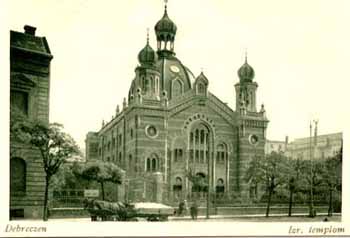 |
A trend to a strict Orthodox approach to Judaism, supported by Moses Sofer of Pressburg, marked the early 19th century. His leadership helped make Pressburg a spiritual center for orthodox Jews, which had many important yeshivas. He promoted the study of Torah, leading to the growth of yeshivas around the country. The Hungarian Rabbinate was important at the time and produced many religious works. Hasidism also spread to northeast Hungary and was introduced by Isaac Taub.
The Haskalah, Jewish enlightenment, came to Hungary in the 1830’s, along with the Reform Movement, both of which countered the Orthodox trends.
The late 19th century, 1869-70, was marked by a religious schism in the Jewish community. There were three main divisions: Orthodox, Neolog (Reform/Conservative) and Status Quo Ante (communities associated with neither of those two movements). Assimilation became widespread among Hungarian Jewry; many young adults began intermarrying.
Zionism was also prevalent in Hungary since the period of Sofer. Sofer recommended that his disciples move to Israel and they became part of the Ashkenazi yishuv movement. The most famous Zionist, Theodor Herzl, was born in Budapest and lived in Hungary during his youth.
In this period, Jews became prominent in the political, economic, and cultural spheres in Hungary. In the 1880’s Jews were active in the liberal professions and in journalism. In 1895, the Jewish religion was officially recognized by the state and given the same rights as Protestant and Catholics religions.
Despite the economic growth and religious empowerment, Jews faced political anti-Semitism in this period. In the 1870’s and 1880’s, anti-Jewish propaganda increased and a blood libel occurred in Tiszaeslar in 1882.
The population reached 910,000 by 1910. Jewish merchants consisted of 55-60% of all merchants in Hungary at the time of World War I. About 10,000 Jews lost their lives on the battlefield in World War I.
Inter-War period: 1919-1939
The Austro-Hungarian Empire was dissolved after its defeat in World War. I. The communist regime gained power and many Jews were active in the upper echelon of the government run by Bela Kun, a Jew. In 1919, the brief Hungary-Soviet Republic ended and was followed by a series of riots and violence against the Jews known as the “White Terror”; more than 3,000 Jews died in the massacres.
By 1920 the political situation stabilized and violence abated. Anti-Jewish sentiments did not wane. Numerous anti-Jewish laws were passed; the enrollment of Jews in higher institutions was reduced to five percent. Zionist activities were stopped for the first couple of years after the war but they were allowed to resume in 1927.
Anti-Jewish legislation continued in the 1930’s. In 1938, the first “Jewish Law” was passed, restricting the number of Jews in liberal professions, administration, and commerce to twenty percent. A second Jewish Law was passed in 1939 that further reduced the economic participation to five percent. Due to these laws, 250,000 Hungarian Jews lost their source of income. Many converted to Christianity, with the number reaching 5,000 converts after the passing of the first anti-Jewish law in 1938
To combat the loss of work and poverty, the Jewish community organization of Budapest developed a social aid program to assist those in need. More than half of Hungary’s Jewish population had moved to Greater Budapest during the inter-war period.
The Holocaust
Hungary joined with the Axis powers (Germany, Austria, and Italy) and thus annexed parts of Slovakia, Transylvania, Yugoslavia and Sub-Carpathian Ruthenia; most of these areas belonged to Hungary, before World War I. By mid-1941, the annexation increased “Great Hungary’s” Jewish population to 800,000.
A “Third Jewish Law” was passed on August 8, 1941, prohibiting intermarriage and changing the definition of Jew to a racial definition. Many Christians thus became “Jews” and the estimated number of “Jews” may have actually been 850,000 in mid-1941.
The first massacre of Hungarian Jews took place in July 1941 when 20,000 Hungarian Jews were expelled from the Galicia region, in Kamentes-Podolski, where the SS and Hungarian troops killed them in the autumn of 1941. Another massacre of 1,000 Jews took place in January 1942, in Bacska region. A third set of Jews, about 50,000, died on the battlefield against the Soviets.
Also in 1942, Hungary’s Prime Minister, Miklos Kallay, ordered that Jewish property be expropriated and he restricted the economic and cultural life of Jews. He proposed a “final solution of the Jewish question,” calling for the resettlement of 800,000 Jews. The Arrow Cross party in Hungary was also responsible for anti-Jewish rhetoric, as well as for persecution.
By 1943, Jews were no longer involved in Hungary’s public and cultural life; however, the Kallay government began holding secret talks with the allies and toned down its anti-Jewish rhetoric.
Germany occupied Hungary in March 1944 because Kallay did not deport the Jews, which was seen as cooperation with the allies. By the time of the German occupation, 63,000 Hungarian Jews had been killed.
In April 1944, Adolph Eichmann ordered the removal of 400,000 Jews from the provincial towns, cities and villages around Hungary to ghettos. Deportation to Auschwitz began in May 1944. All communities besides those in Budapest were put in ghettos or concentration camps. In June, the first group of deportees (about 7,000 of the city’s 12,000 Jews) from Debrecen were sent to Austria and about one-half of these survived the war. Most of the other Jews were deported to Auschwitz.
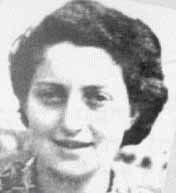 |
About 2,000-2,500 Jews were able to escape to Romania during the ghettoization period. Others escaped to Budapest. Relief efforts were sponsored by the Zionists, who helped Jews with fake passports, food, clothing and places to hide. The Haganah was actively involved in trying to save Hungarian Jewry. Two famous paratroopers that attempted to save lives included Hannah Senesh and Perez Goldstein.
Another 1,658 Jews were bought and were delivered to Switzerland for $1,000 a person. The fate of the Hungarian Jews was published in the Swiss press and in other neutral countries, leading to a suspension of deportation ordered by Heinrich Himmler. Many Hungarian Jews were placed in the protection of neutral states, Sweden, Switzerland and Portugal.
Two well-known individuals involved in saving Hungary’s Jews were Charles Lutz, a Swiss diplomat in Hungary, and Raoul Wallenberg, secretary of the Swedish Legation in Budapest.
The deportation process of Budapest’s Jews began in October 1944. The majority of the Budapest Jews were sent to a central ghetto, while some managed to live in “protected ghettos” in quarters protected by various neural states.
Death marches to Austria were ordered for the Budapest Jews and it is estimated that about 98,000 Jews from Budapest lost their lives in these marches by January 1945.
At the end of the war, 69,000 Jews remained in Budapest’s central ghetto and 25,000 remained in the “protected ghetto.” Approximately 25,000 Jews came out of hiding in Budapest, a few thousand lived in Red Cross children’s homes and others returned from labor camps, from the Soviet Union and from other regions. Of the original 825,000 Jews before the war, 260,000 Hungarian Jews survived and 565,000 perished. About 4,000 Jews from Debrecen survived the war. The other survivors were mainly from Budapest; most of the Jews from the small towns were murdered.
Post-World War II Hungary
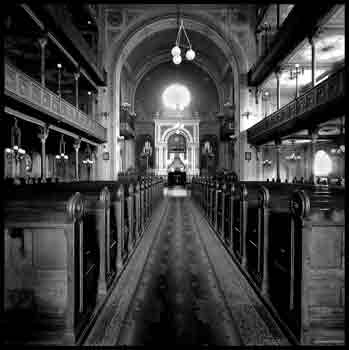 |
After the war, about 250 Jewish communities were reestablished. Most of the communities in the small towns faltered, however, and most Jews moved to the capital or emigrated.
The Hungarian government abolished anti-Jewish legislation and put to trial and imprisoned those involved in the deportation and destruction of the Jews; however, no law was passed to return property lost or confiscated in the Holocaust. Anti-Semitism was banned, but anti-Jewish sentiments still continued. Pogroms broke out in 1946 in Kunmadaras, Miskolc and in other communities.
The Jewish community institutions were renewed after the war. In December 1948, the government officially recognized the Jewish community, guaranteed freedom of religious practice and promised financial support. One single Jewish community organization emerged for the three main movements: Orthodox, Neolog and status quo.
The Zionist movement began building schools and youth institutions. Many Hungarian Jews immigrated to Israel. Diplomatic relations with Israel were established in 1948.
In this period, the American Jewish Joint Distribution Committee gave money to rebuild the Jewish community and help pay for food, welfare and education.
In February 2014, Budapest’s Unified Hungarian Jewish Congregation announced the discovery of the largest single collection of “priceless confiscated sacred property of the Hungarian Jewish community in the Holocaust.” The discovery was of 100 Holocaust-era Torah scrolls. Additionally, Hungary and the U.S. State Department are attempting to retrieve a Sarospatak library from Russia.
Communist Rule
IIn 1949, the communists gained power and Hungary became the people’s republic. The communist rule led to the closure of many Jewish institutions and the arrest of Jewish activists. Zionism and mass immigration to Israel were not allowed and contact between Hungarian Jewry and world Jewry were curtailed. Jewish educational institutions became part of the general school system.
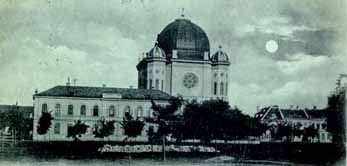 |
Expulsions from the cities to the provinces took place in 1951, about 20,000 Jews (most from Budapest) were forced to leave the cities. In 1953, the situation eased and Jews were allowed to return to their homes. In the 1956 Hungarian Revolution, it is estimated that 20,000 Jews left Hungary.
Liberalization policies were enacted in the late 1950’s, however, those Jews outwardly identifying with Judaism and engaged in religious activities were restricted in economic and social spheres. Contact with world Jewish organizations resumed in the 1960’s. In 1967, the Hungarian Jewish population numbered 80-90,000, including those who did not participate in Jewish communal life. The largest community was in Budapest, which has 20 synagogues.
In 1967, diplomatic ties with Israel were severed, but commercial ties continued.
The number of Jews in Hungary continued to decrease and, in the 1970’s, declined to 60,000 (50,000 lived in Budapest), which was still the second or third largest community in Eastern Europe. Almost 60 percent, of the Jews, however, were over the age of 50.
The collapse of the communist government in 1989 brought the end of restrictions placed on the Jewish community and with relations with Israel.
Hungary Today
Assimilation is a major problem in Hungary. Anti-Semitism remains a problem, even into the twenty-first century. In recent memory, attacks by “nationalists” and skinheads on foreign students, gypsies, and Jews in 1992 and in 1993 stands out. The rise of the Jobbik party of Hungary in 2012 parallels a rise in anti-Semitic attitudes among the general population. An Anti-Defamation League poll in February 2012 found that 63 percent of Hungarians agreed with three out of four anti-Semitic statements about Jews and money, Jewish disloyalty to the state, and Jews and the Holocaust.
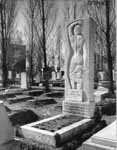 |
The leading Jewish communal organization in Hungary is the Alliance of the Hungarian Jewish Communities. There are three Jewish day schools in Budapest, as well as a high school, the Anne Frank Gymnasium. There are a number of Jewish youth camps and clubs, including chapters of B’nei Akiva, B’nei Brith Youth Organization, Habonim Dror, Hanoar Hacioni, Hasomer Hacair and the Hungarian Union of Jewish students. The Zionist movements began functioning again, including the Hungarian Zionist Alliance and Women’s International Zionist Organization. There are also many cultural Jewish institutions and organizations. The Federation to Maintain Jewish Culture in Hungary tries to combat assimilation and preserve Jewish heritage.
There are a number of Jewish-Christian dialogue groups, as well as welfare institutions and organizations to help the elderly. There are Jewish nursing homes and organizations to help Holocaust survivors.
A Jewish Museum can be found in Budapest. There is also a Jewish community center, theaters, numerous bands, choirs and dance ensembles.
There is a Jewish newspaper produced twice a month in Budapest, which focuses on the happenings of local Jewry, as well as a Jewish magazine produced once a month, a Jewish literary and an arts journal and publications from other communities, Chabad and other Jewish organizations.
There are 12 rabbis in Hungary, most belonging to the Neolog stream of Judaism. In Budapest, there are 20 synagogues and prayer houses exist in the small towns. Budapest hosts Eastern Europe’s only rabbinical seminary, founded in 1887; it is Neolog in practice and students attend from neighboring countries.
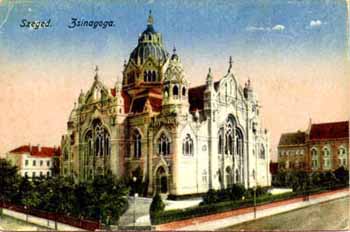 |
Jews who settled in Szeged at the end of the 18th century built a synagogue in 1803 and replaced it with another in 1839. This later synagogue was used until 1903, when the Great Synagogue was completed. The Great Synagogue depicted in the following postcard was the result of a design competition held in 1898. The synagogue survived the war and has been declared an architectural monument.
In 2004, the Mad Synagogue was restored. The architecht, Peter Wirth, received a Europa Nostra award for his design. The Mad Synagogue was originally built in 1795, but was destroyed after the Holocaust. Wirth attempted to maintain the original structure of the synagogue as he was rebuilding.
Because there are no Jews living in Mad, the synagogue is used as a memorial and a museum. During World War II, 800 Jews from the village were deported to Auschwitz. They synagogue contains plaques memorializing these Jews. Wirth has plans to rebuild the yeshiva that was originally attached to the building. He also hopes that the synagogue’s rebuilding will bring back Jews and Jewish traditions to Mad. Wirth has also helped to restore over 10 other synagogues throughout Hungary.
The synagogue is technically owned by the Hungarian government because they funded ninety percent of the project. The other ten percent was donated by the World Monuments Fund.
There are 10 kosher butchers, a kosher bakery and a restaurant in Budapest. Hungary also exports matzah, kosher wine and meat.
In September 2019, a new synagogue and community center was opened in Szentendre by EMIH, a Hungarian Orthodox Jewish group affiliated with Chabad-Lubavitch. The complex will have a prayer sanctuary, classroom and playground facilities for children, a kosher café, and a small art gallery with Judaica and Jewish art. The once flourishing Jewish community in the city was wiped out during the Holocaust and now has roughly 400 Jews.
The same day, another synagogue, opened in Budapest in what is planned to be the largest Jewish community center in Hungary that will include a Jewish theater, a playground, two kosher restaurants, and an informal study center.
“Historically, I don’t think there was ever — certainly not since the Holocaust – a day in Budapest where two synagogues opened on the same day, and two Torah scrolls were finished in one day, so I think this really represents this resurrection of Jewish life that we’re so strongly fighting for,” EMIH executive Rabbi Slomo Koves told The Times of Israel.
Relations with Israel
During a press conference in the Hungarian parliament following meetings with Israeli Prime Minister Netanyahu on July 18, 2017, Prime Minister Viktor Orban expressed regret that his country neglected to protect its Jewish citizens during the Holocaust. “At an earlier time, the government of Hungary made a mistake, moreover, committed a sin when it did not protect its citizens of Jewish heritage,” Orban stated. “Hungary decided that instead of protecting the Jewish community, we chose collaboration with the Nazis.”
Netanyahu was the first Israeli Prime Minister to visit Hungary since 1989, when the country was still under communist rule. The two countries have subsequently grown much closer. During a visit to Israel in February 2019, for example, Prime Minister Viktor Orban announced Hungary will open a trade office in Jerusalem that will have official “diplomatic status.” The mission opened on March 19.
Original Article by Rebecca Weiner
Sources: Letter to the Editor, Anti-Semitism in Hungary,
New York Times, (April 25, 2012);
Graves Desecrated in Jewish Cemetery in Hungary,
Haaretz, (July 22, 2012);
Joshua Levitt, Hungarian Jewish Community Discovers 100 Holocaust-Era Torah Scrolls Confiscated in WWII,
Algemeiner, (February 17, 2014);
Maureen Shamee, “Germany rejects EU's labeling of Israeli settlement products, says Bundestag President,” European Jewish Press, (December 3, 2015);
“Czech parliament rejects labelling goods from Israeli settlements,”YNet News (December 17, 2015);
Pablo Gorondi, Hungary’s Orban: Collaboration with Nazis was mistake, sin,
Washington Post, (July 18, 2017);
Raphael Ahren, “Hungary to open office with ‘diplomatic status’ in Jerusalem,” Times of Israel, (February 19, 2019);
Herb Keinon, “Hungary Opens ‘First European Diplomatic Mission In Jerusalem In Decades,’” Jerusalem Post, (March 20, 2019);
Yaakov Schwartz, “Confident that Jews will fill pews, Hungary’s Chabad opens 2 synagogues in a day,” Times of Israel, (September 23, 2019).
Photo credits:
Memorial stone courtesy of History of the Jews in Hungary.
Synagogue photos courtesy of Judaica Philatelic Resources.
Budapest photos courtesy of the Tourism Office of Budapest.
Map from the CIA World Fact Book 2000.
Pecs Synagogue © Edward Serotta.



